
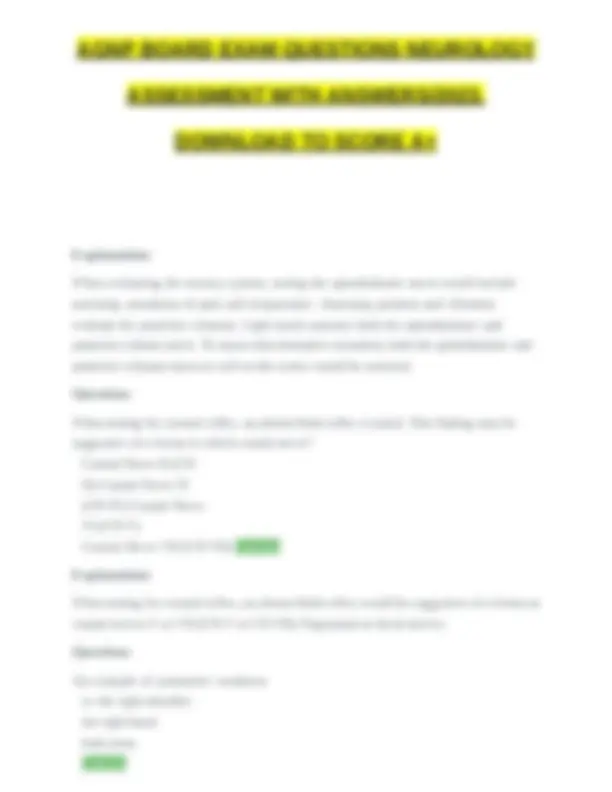
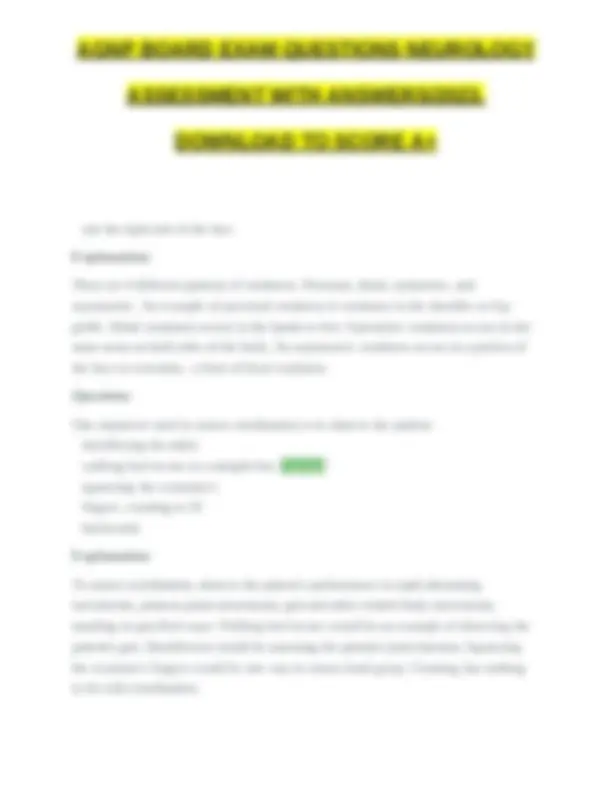
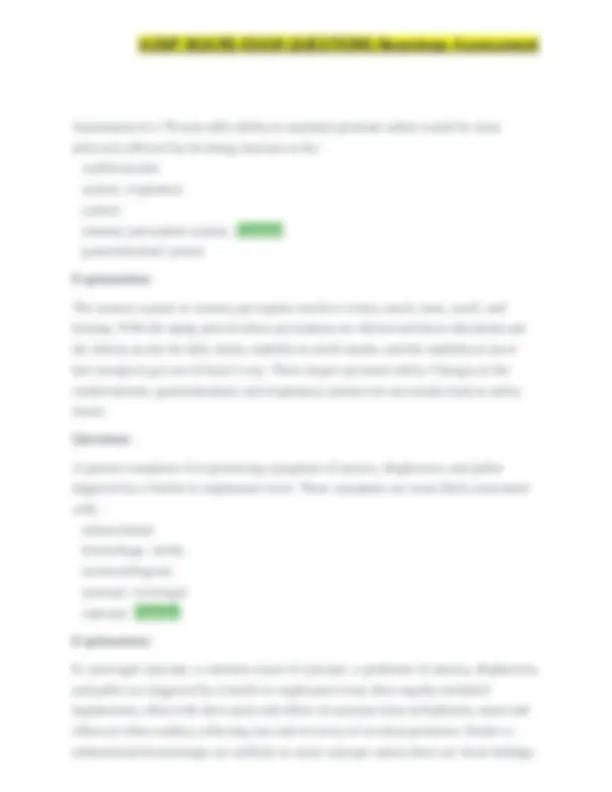

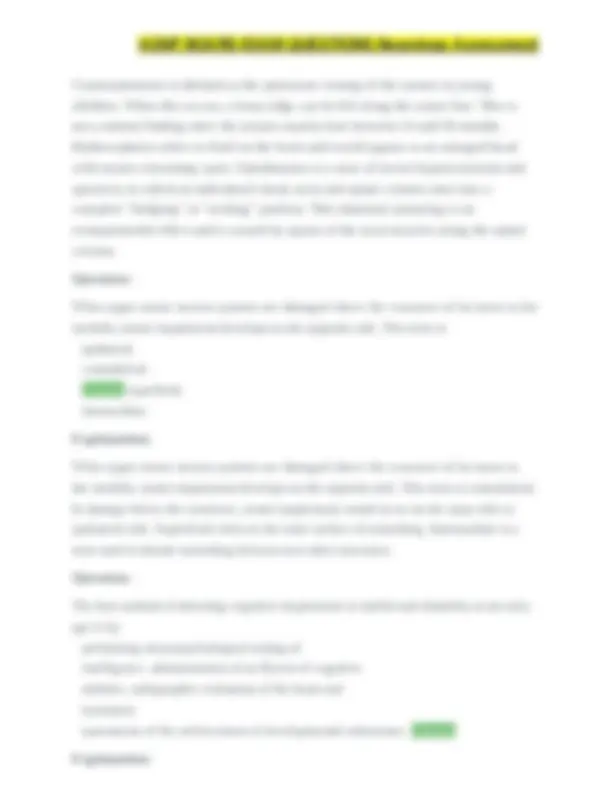

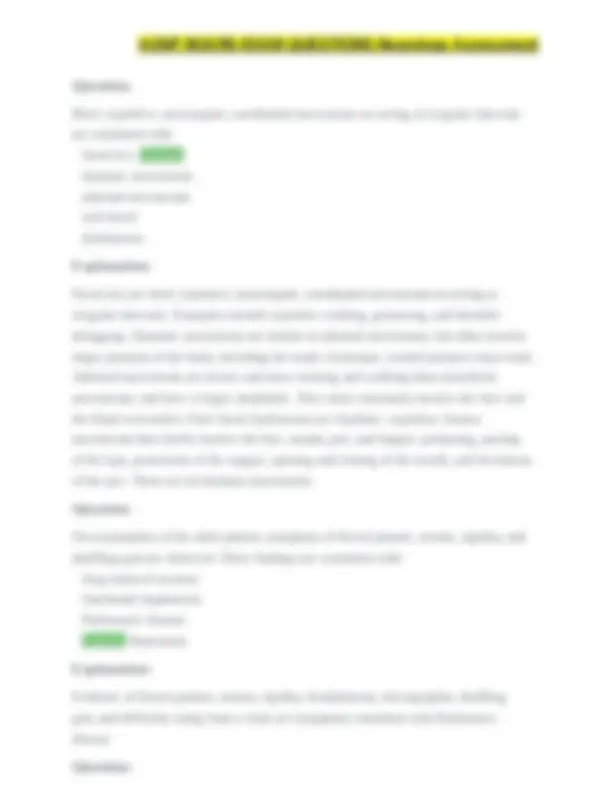
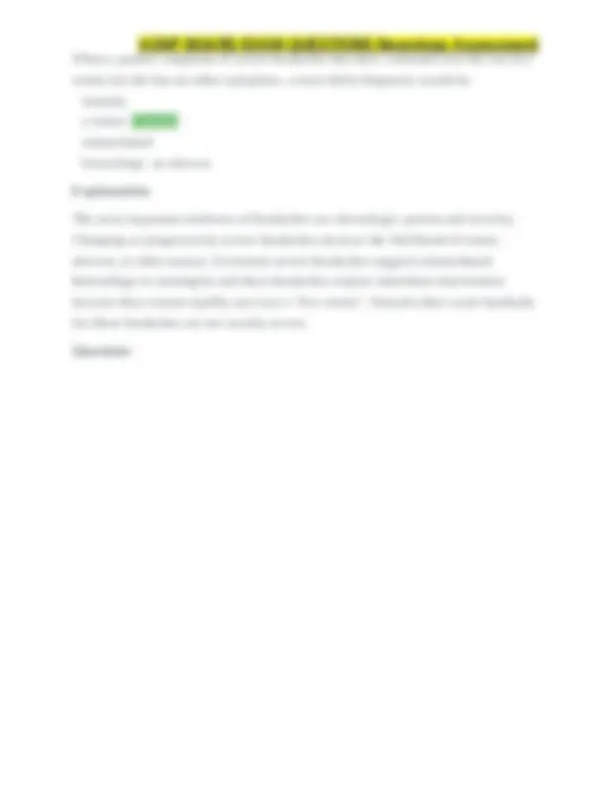




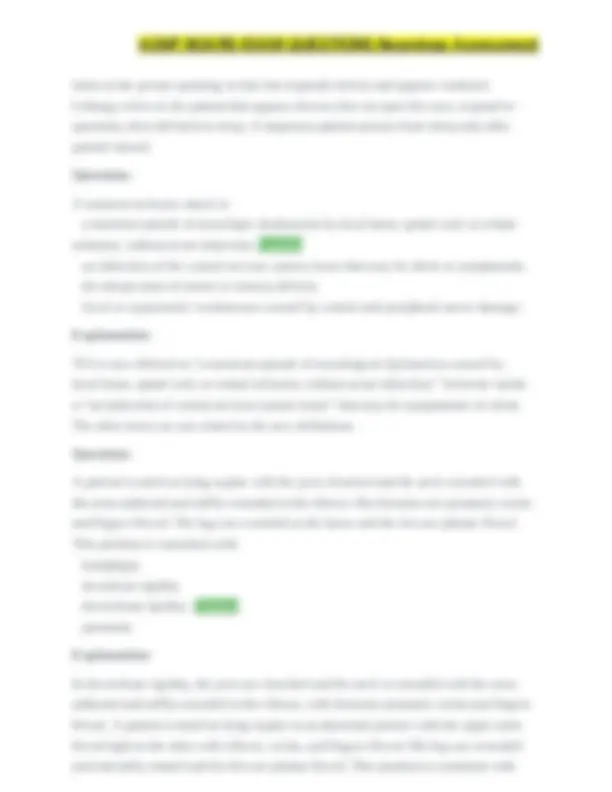

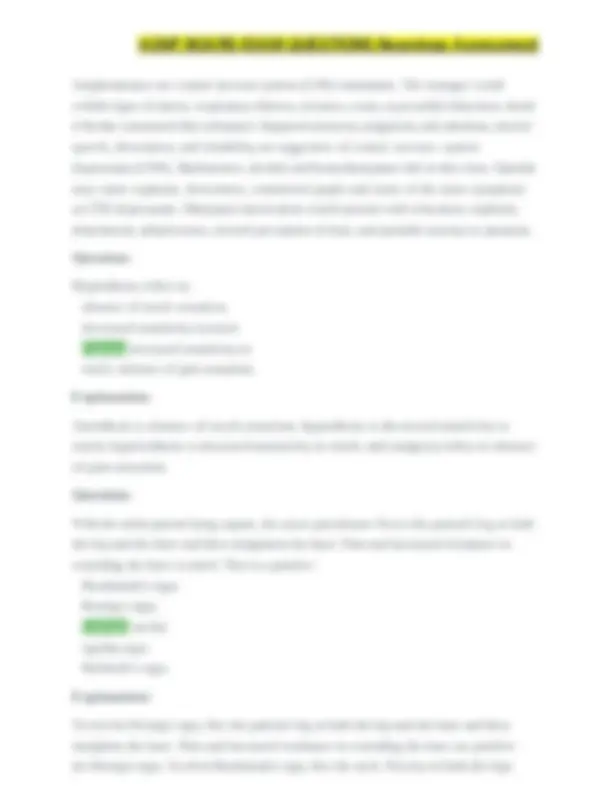

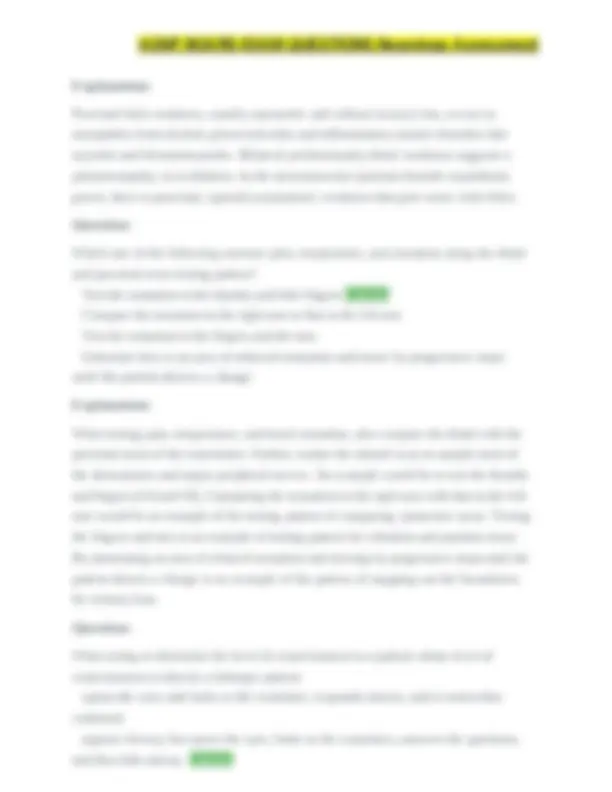
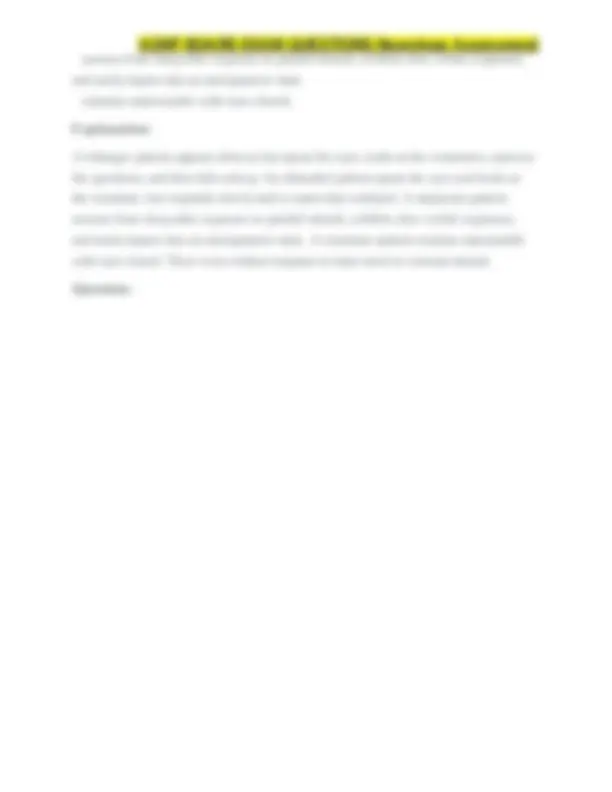

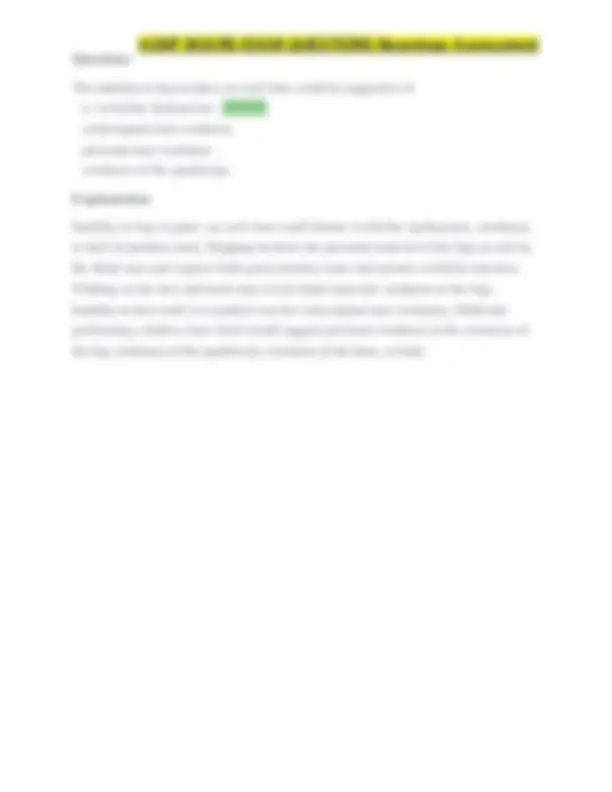
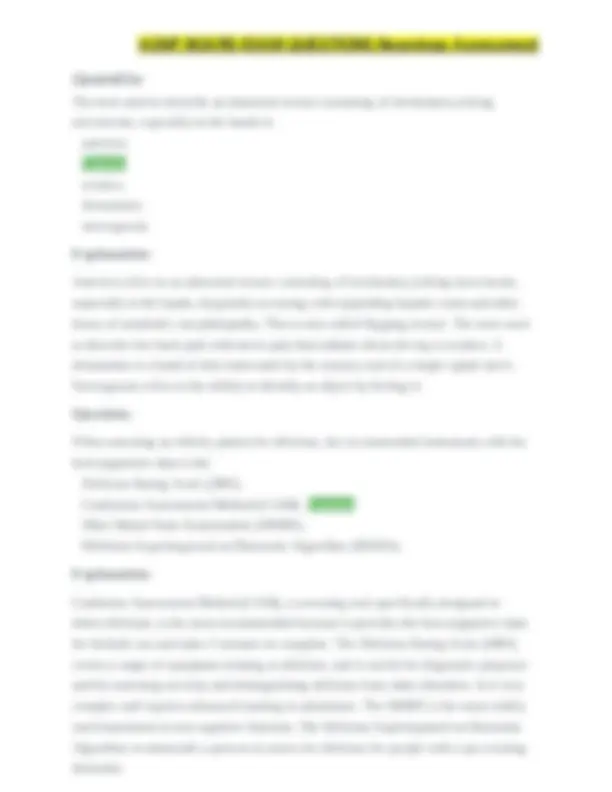
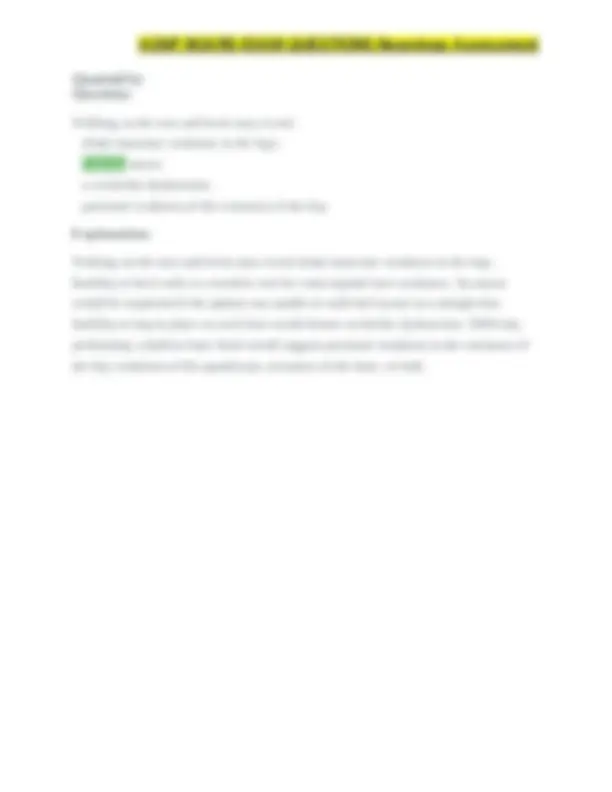
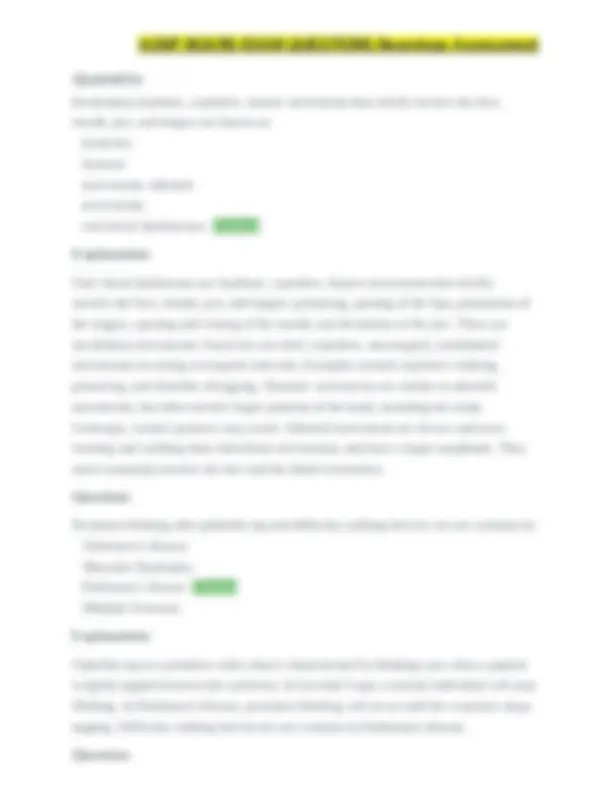
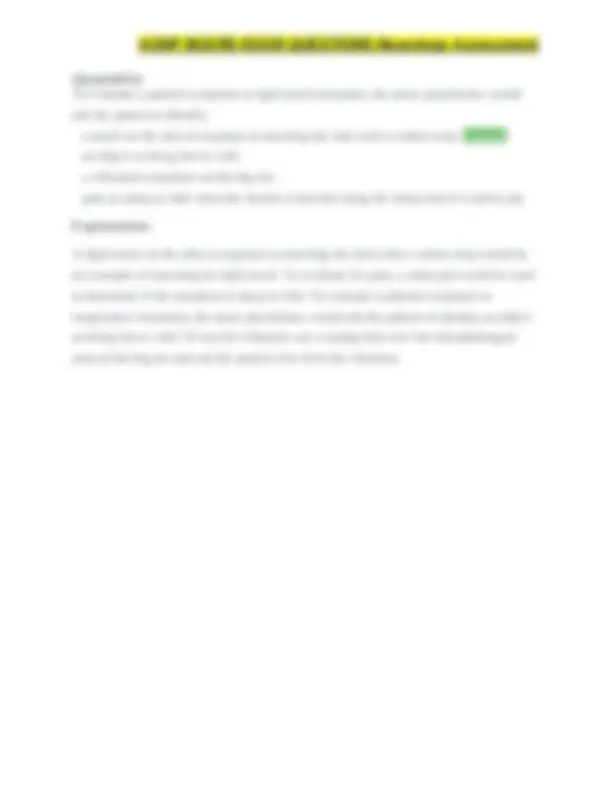
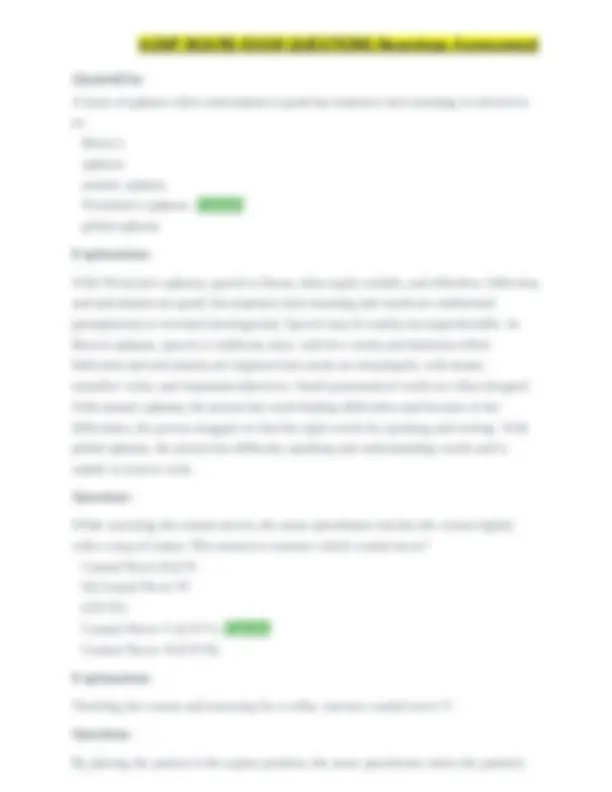
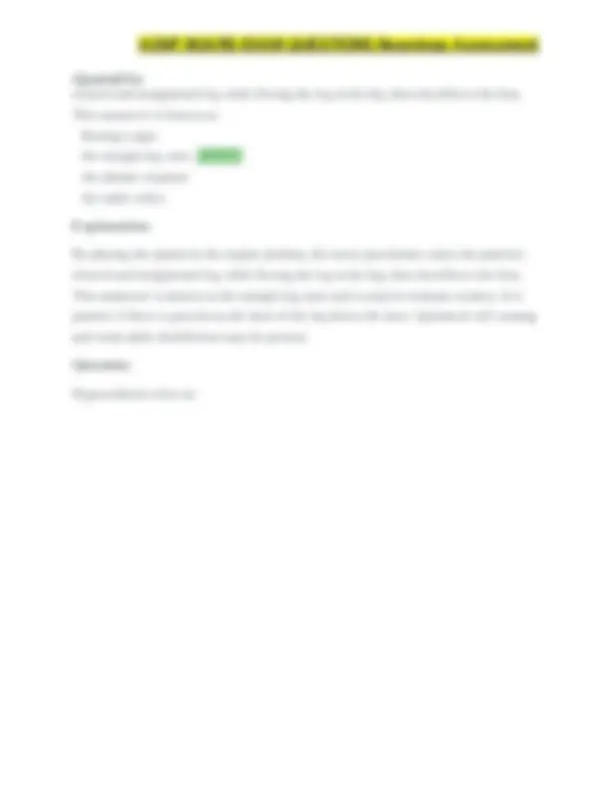
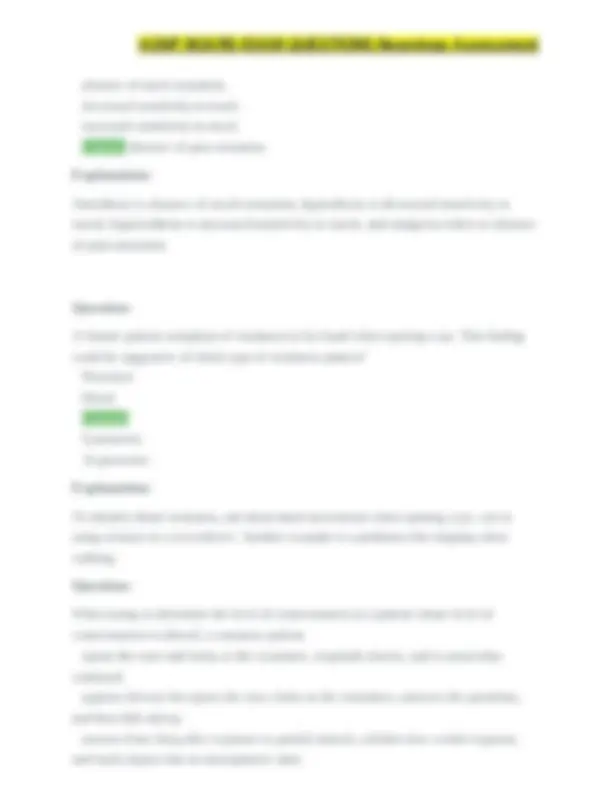
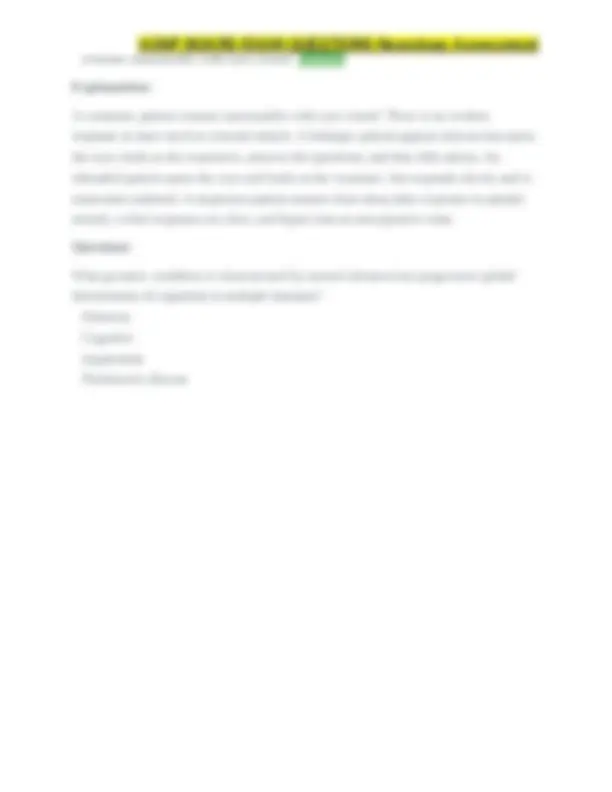
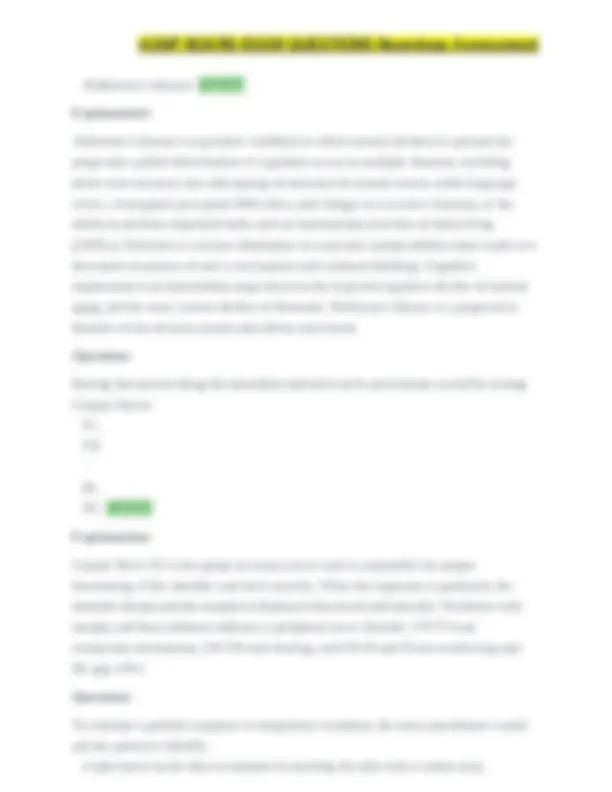
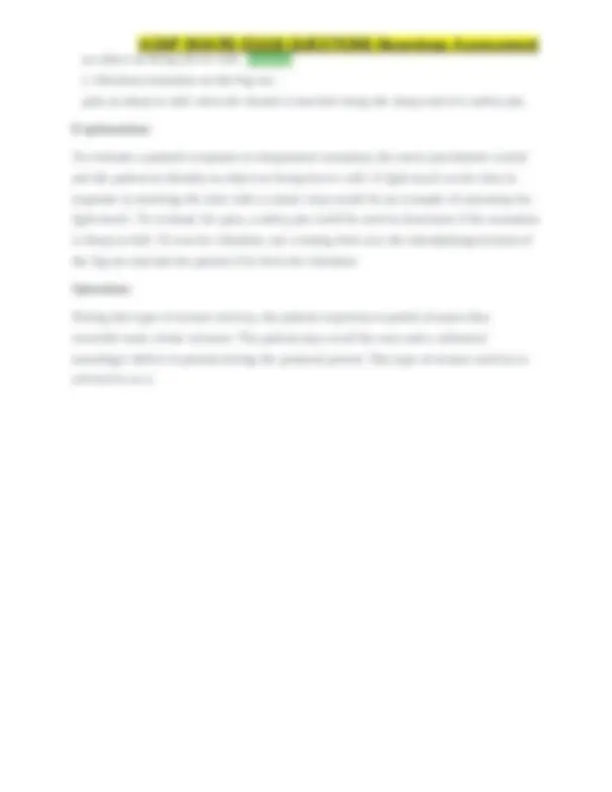
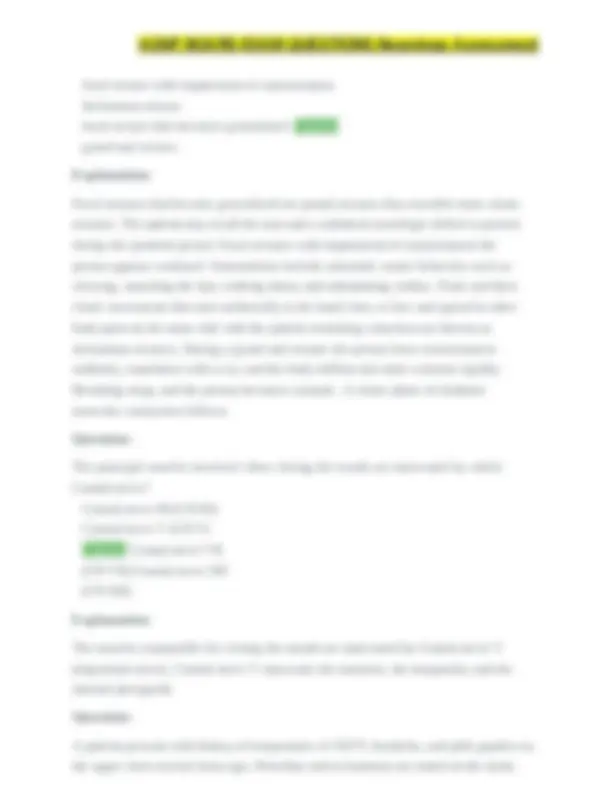
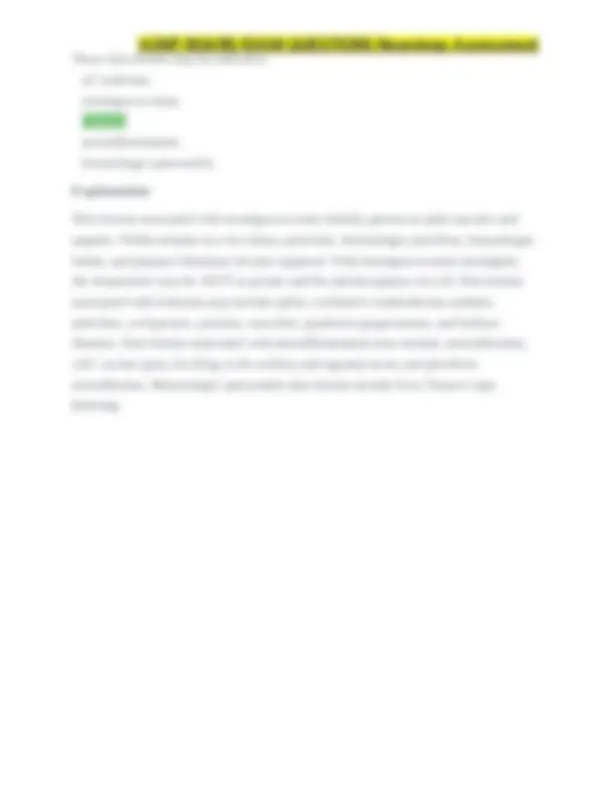
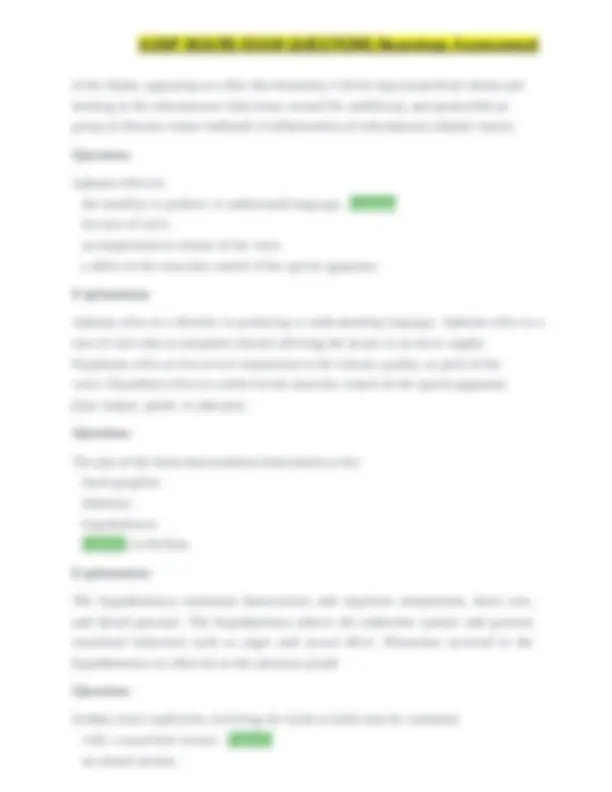
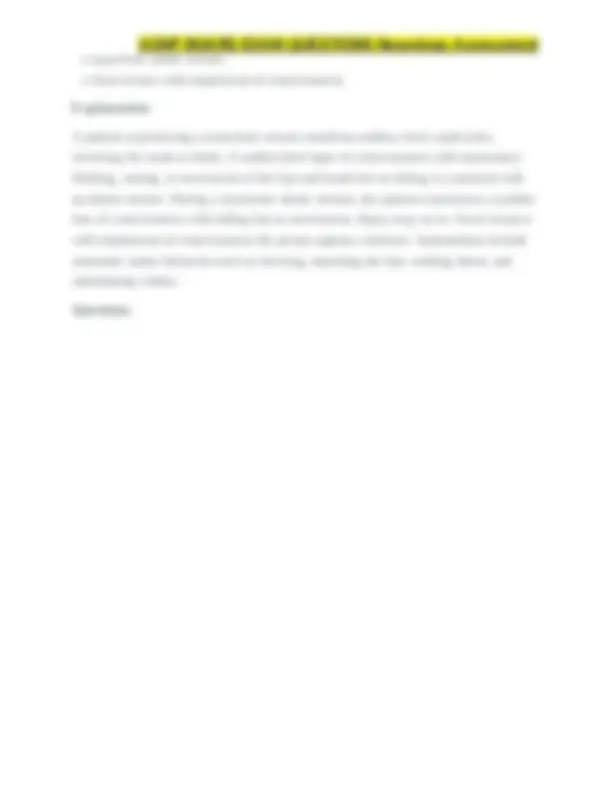
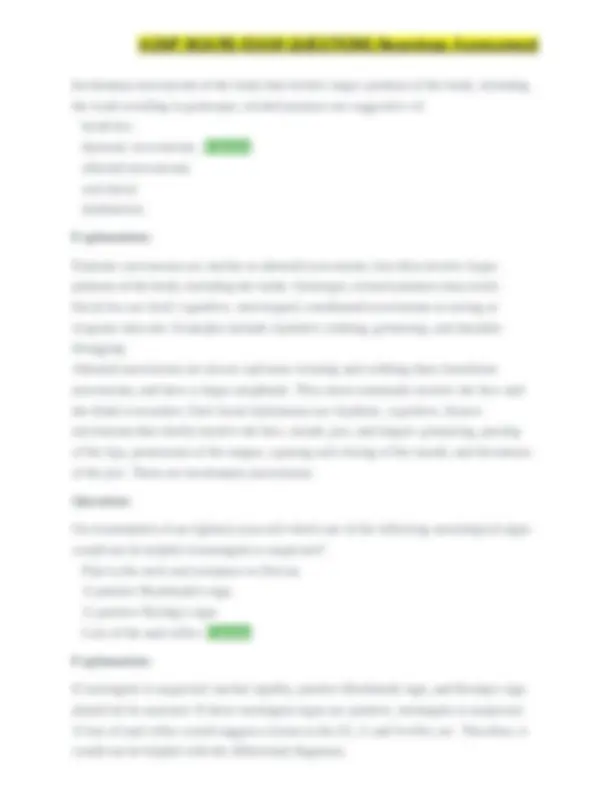
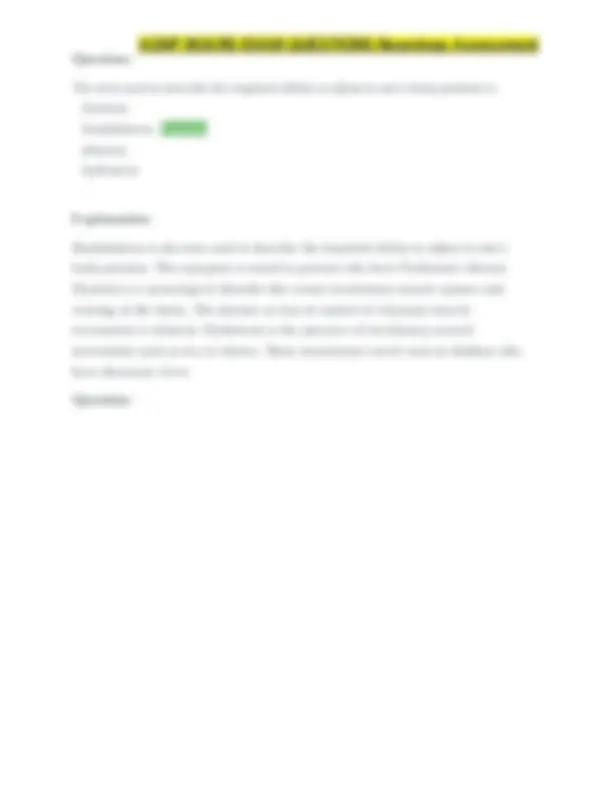
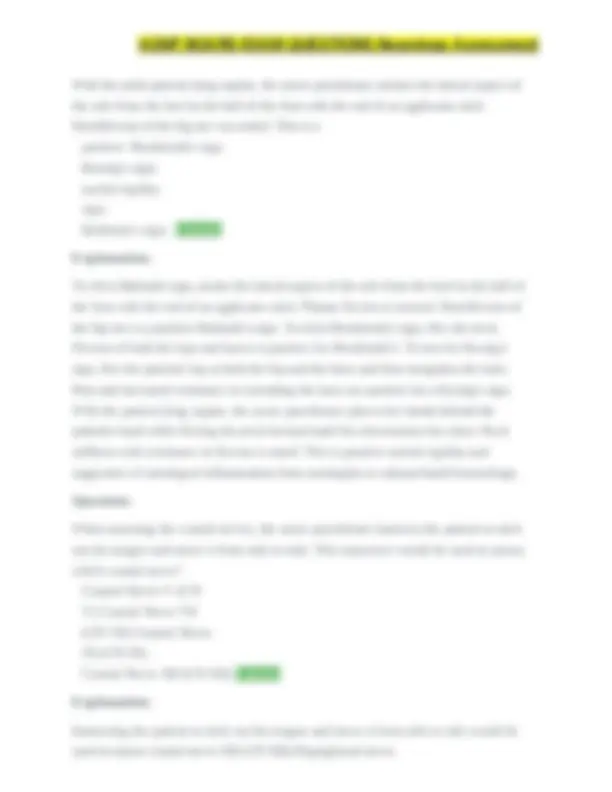

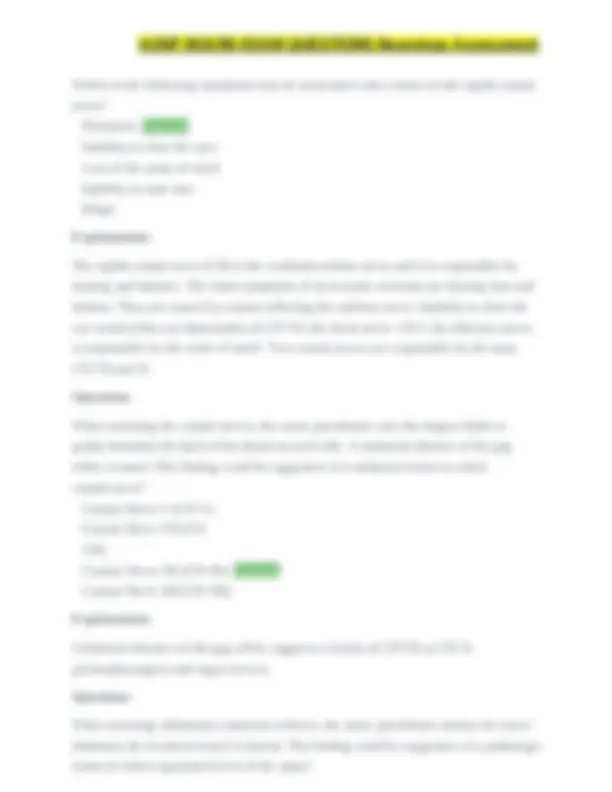

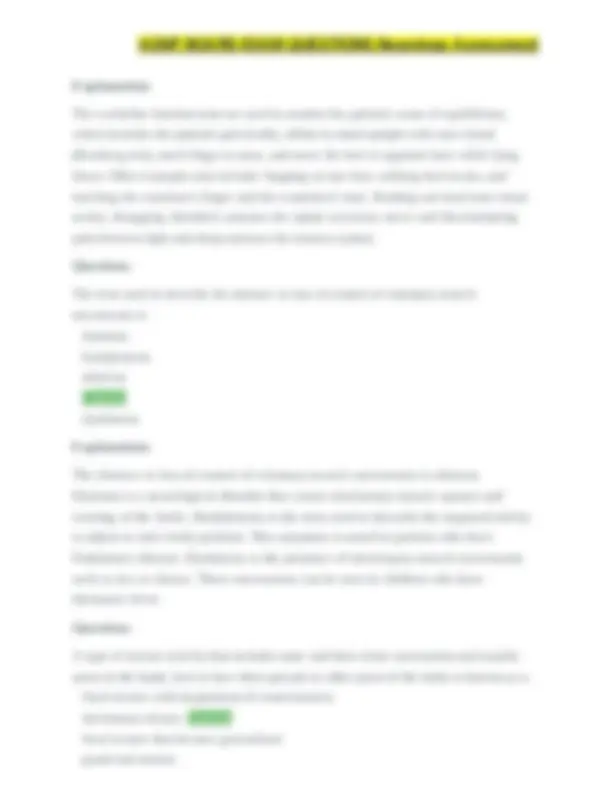
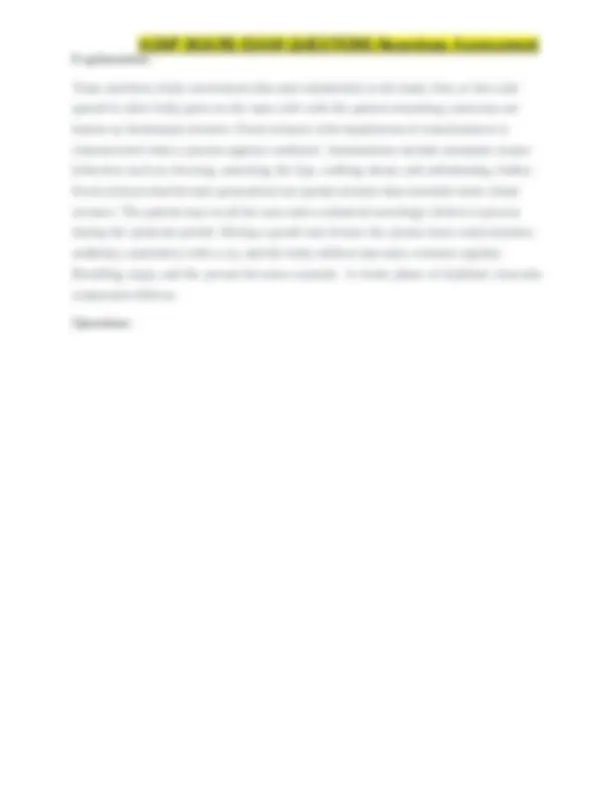

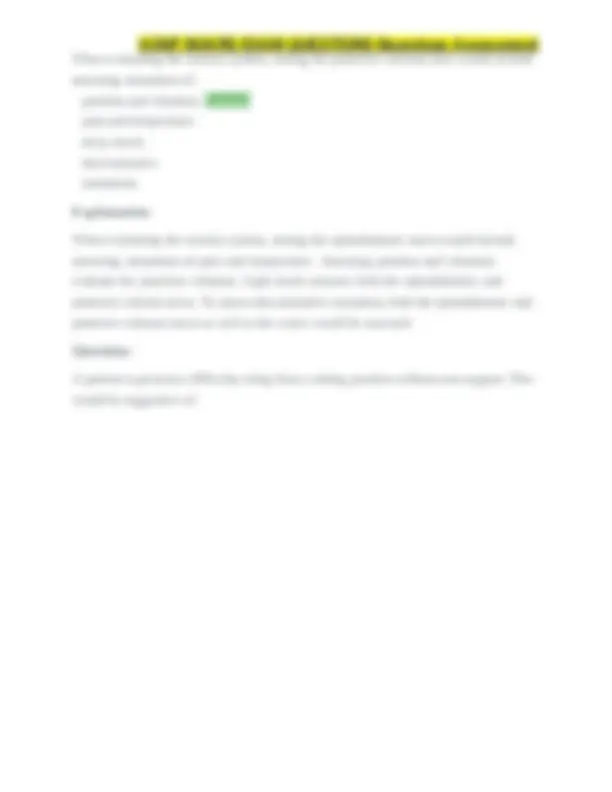
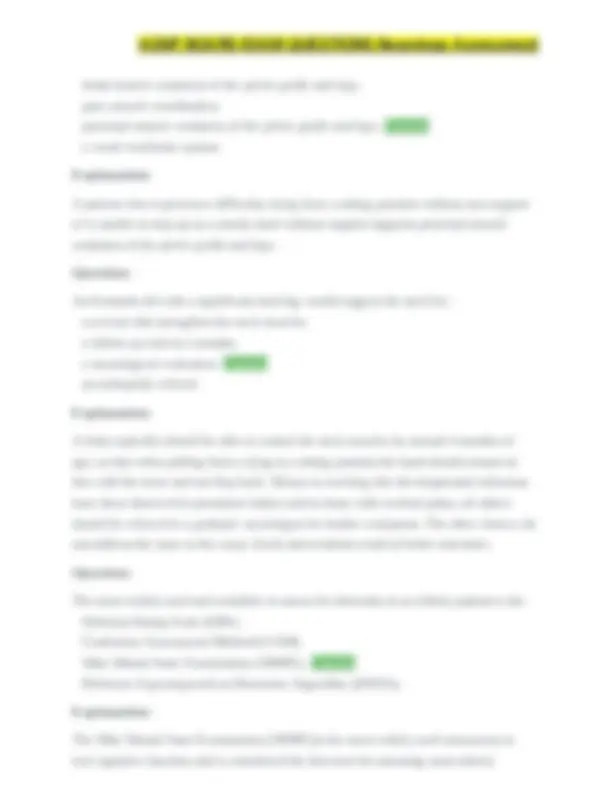
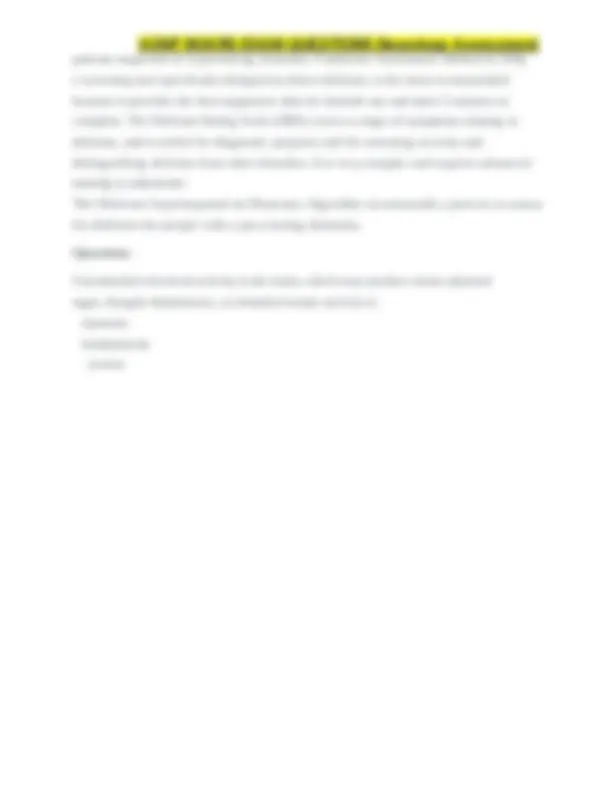
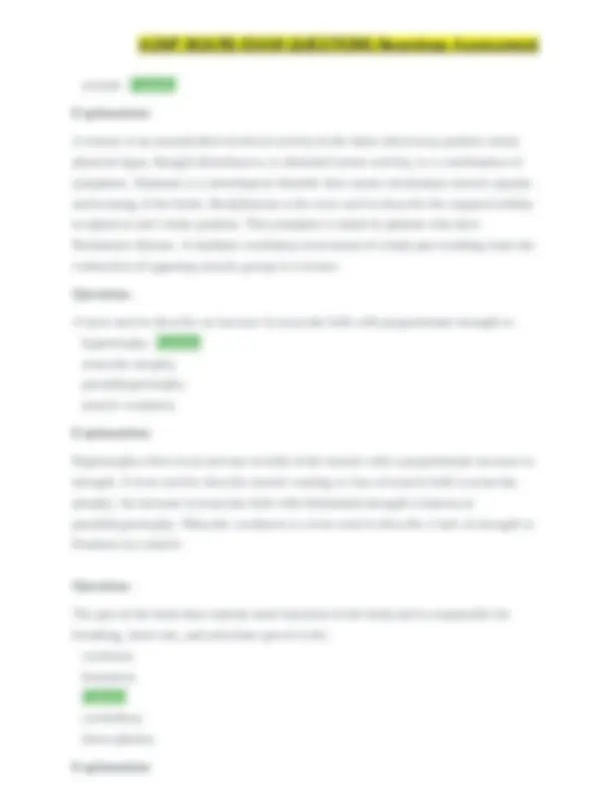
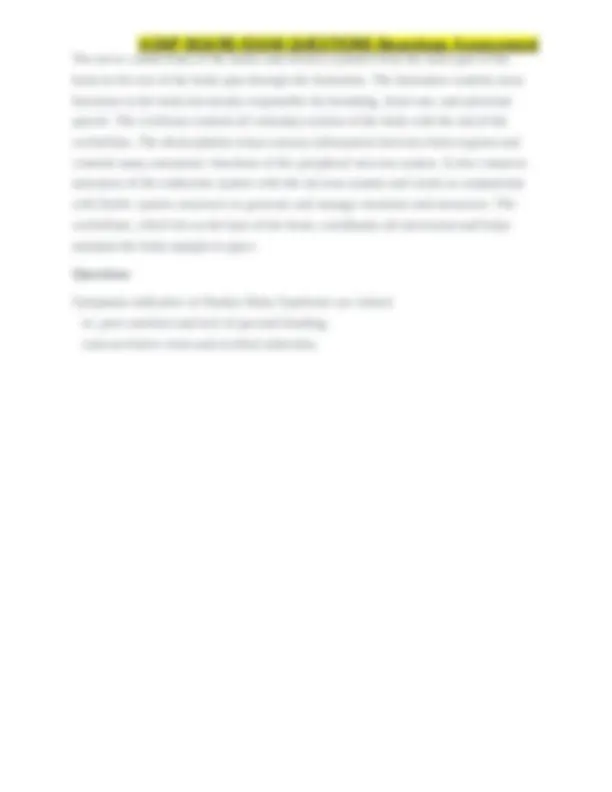




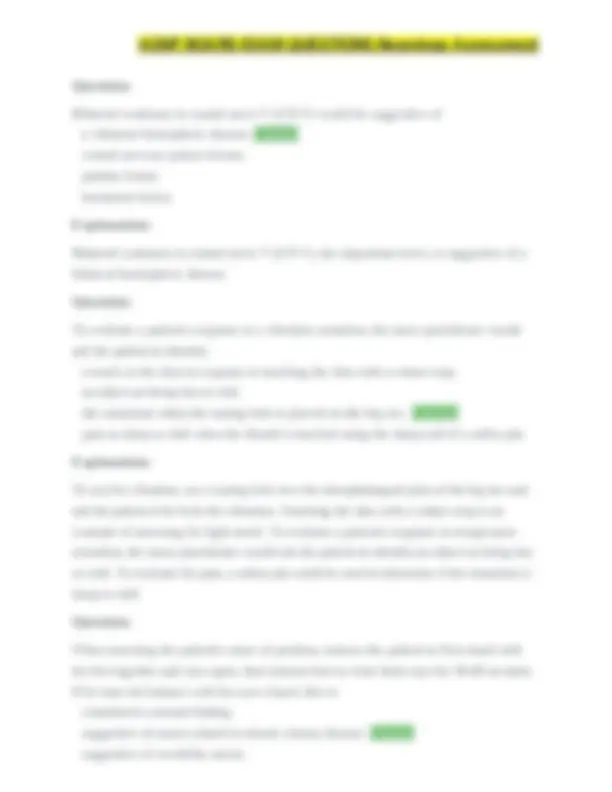
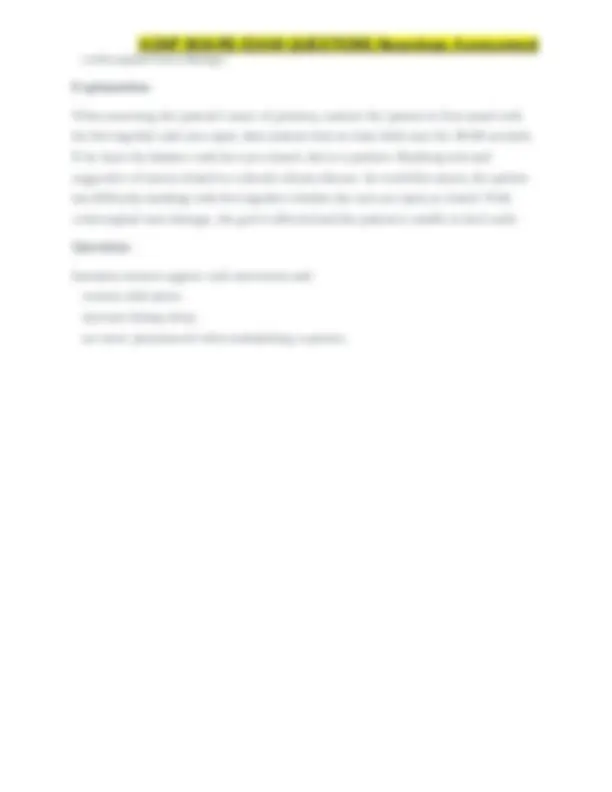
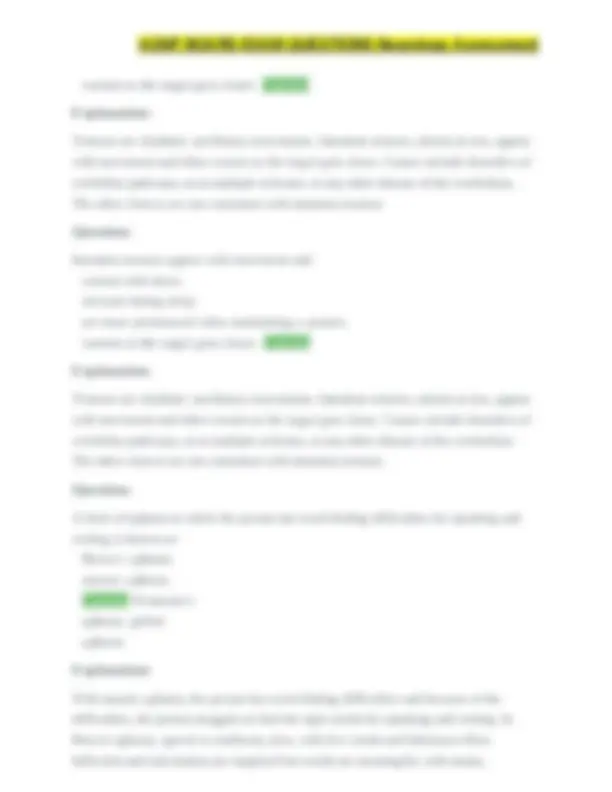



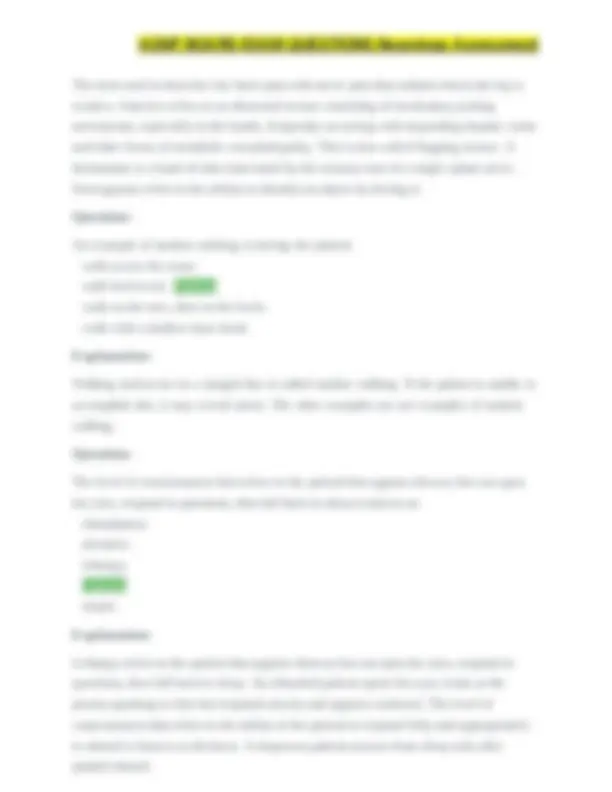

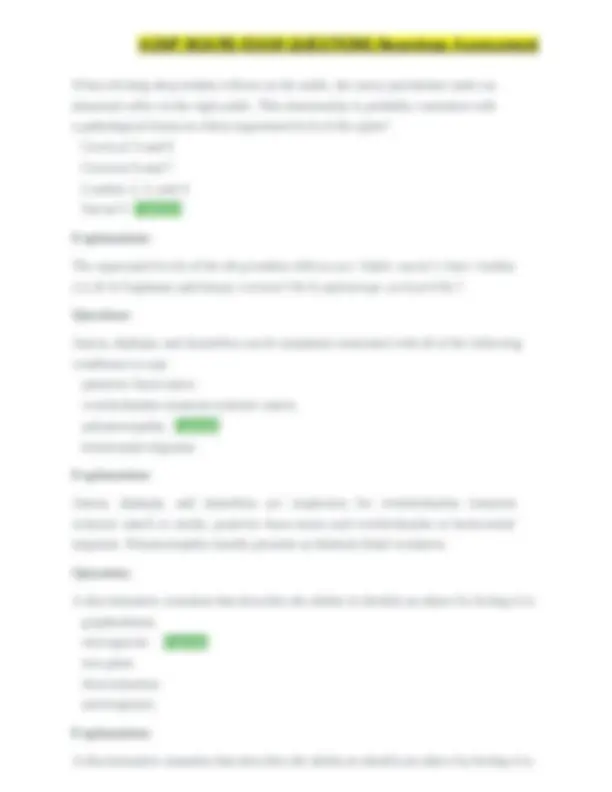

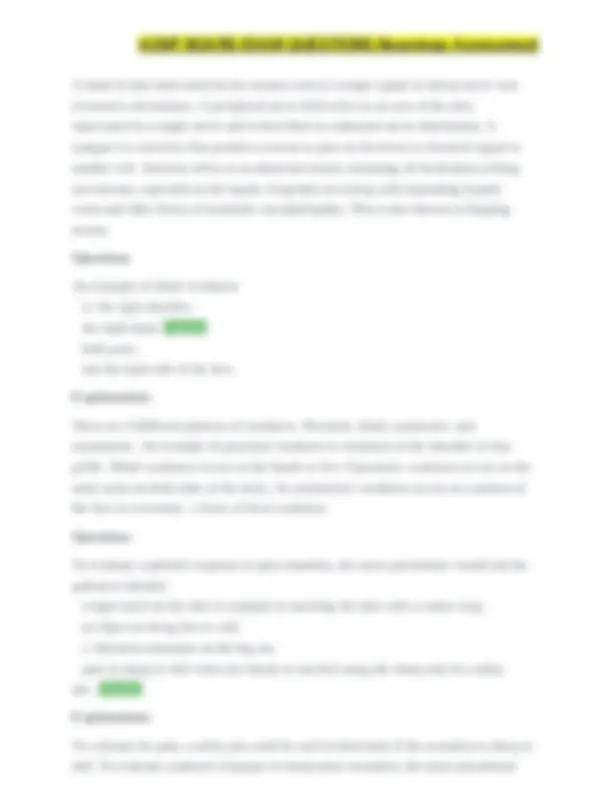

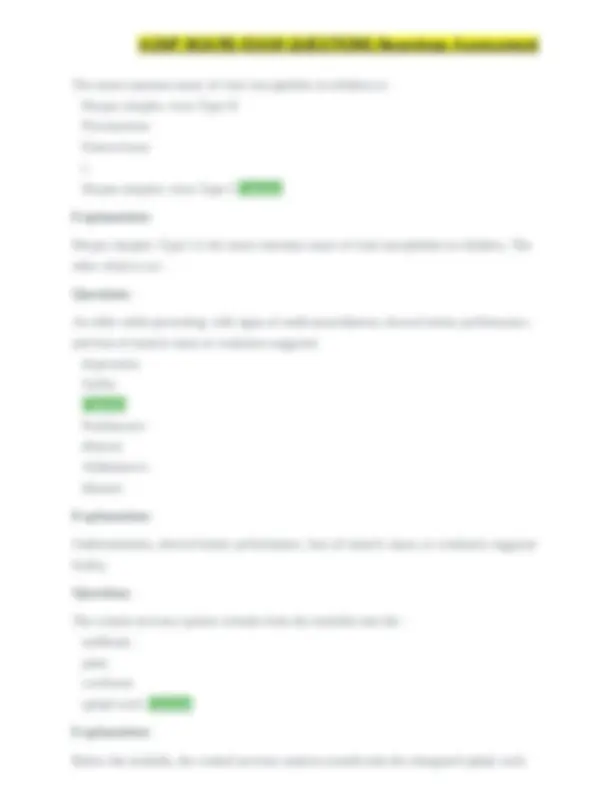

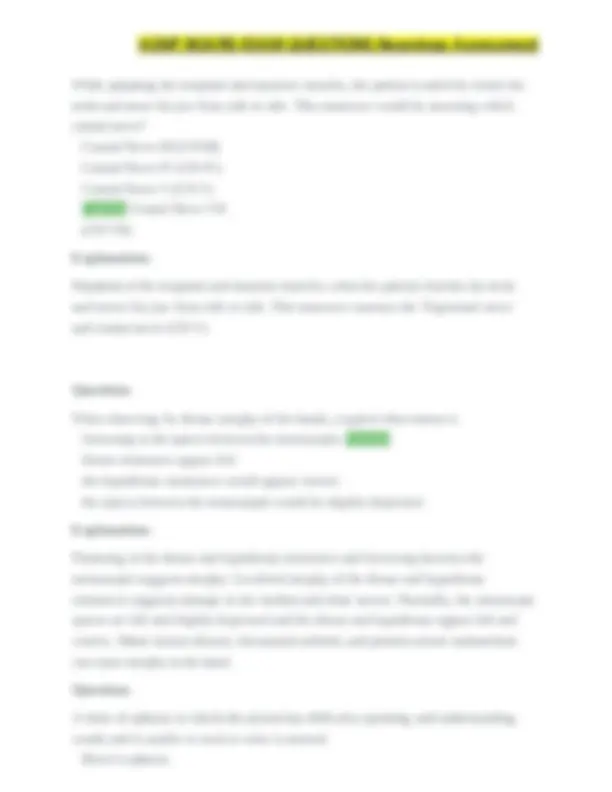
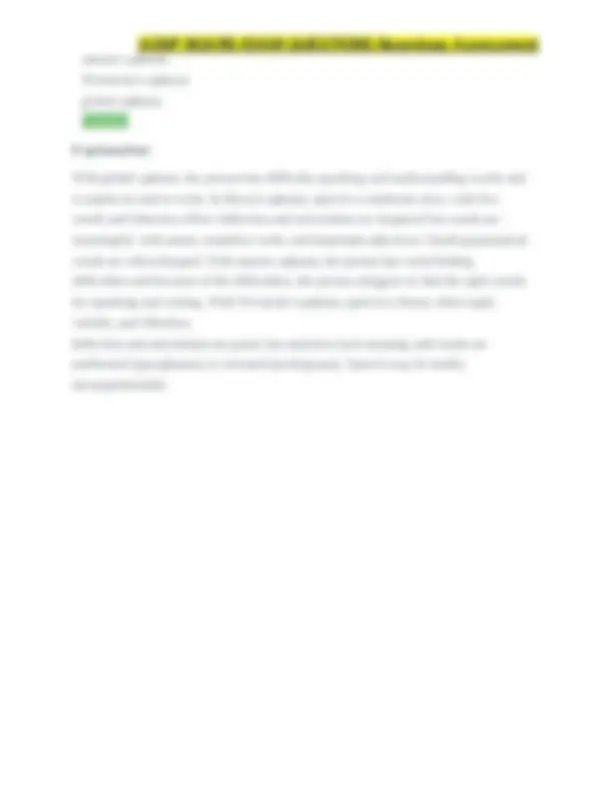
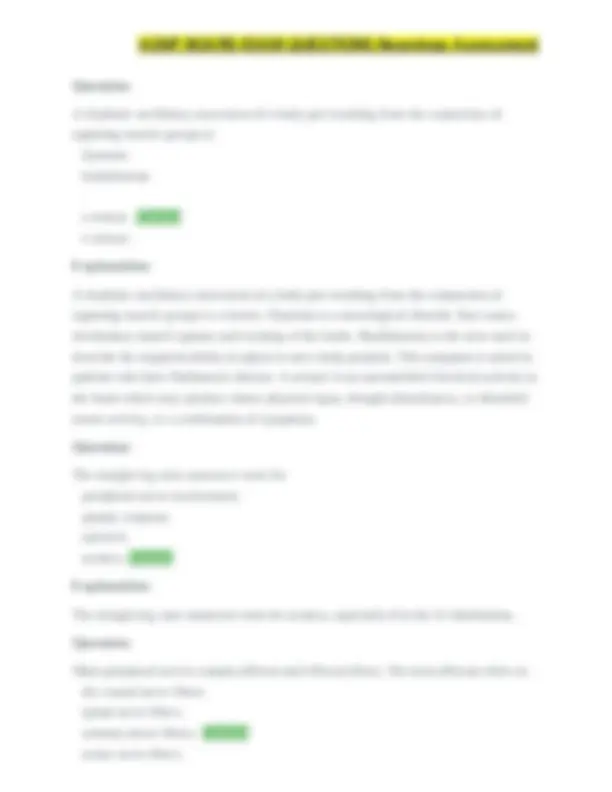

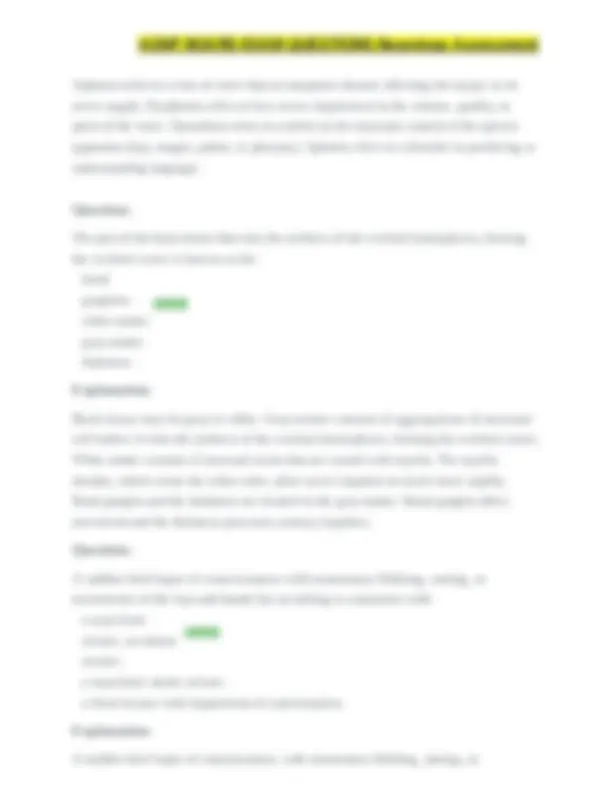

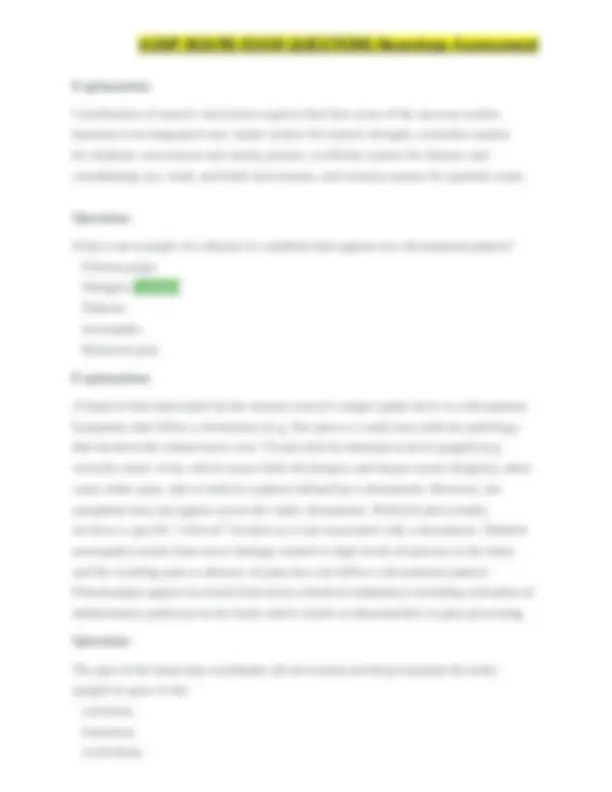
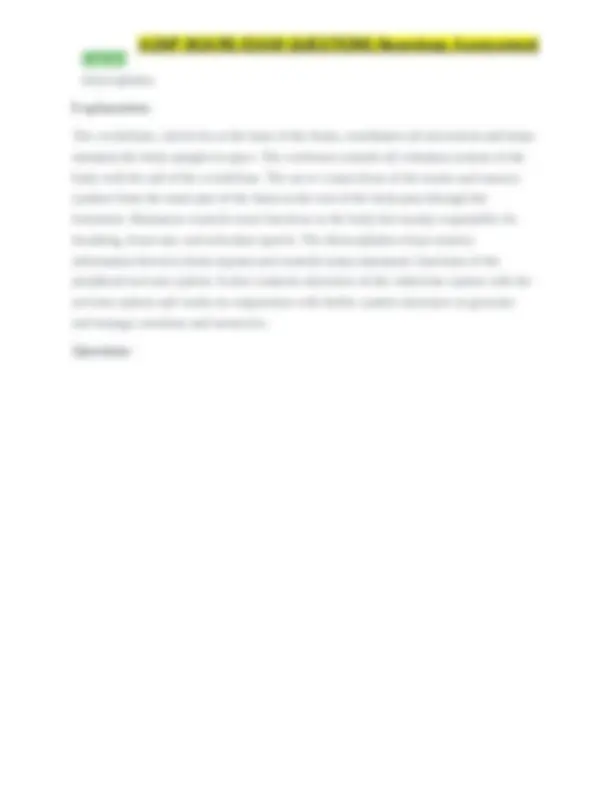
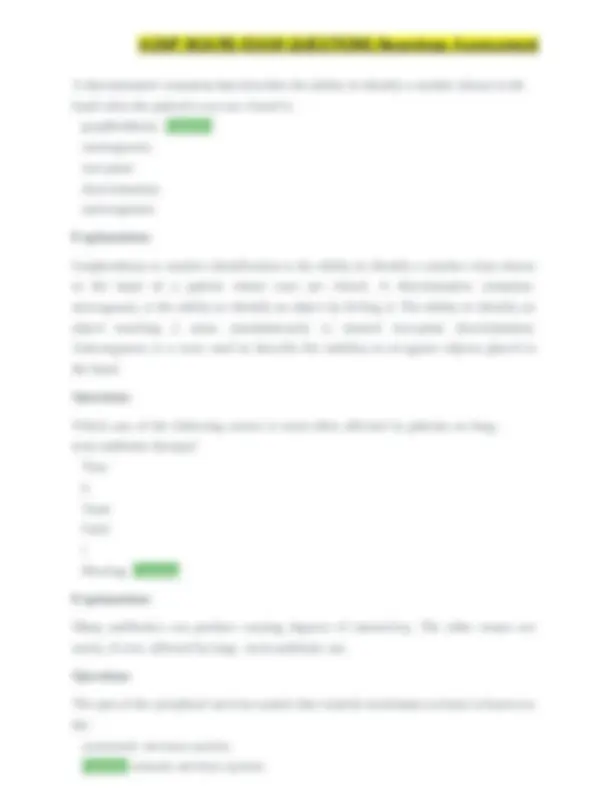

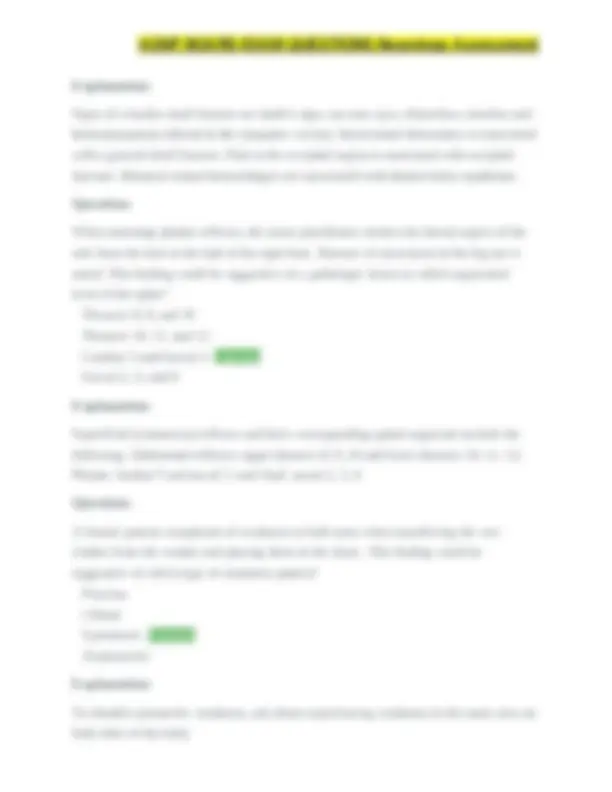
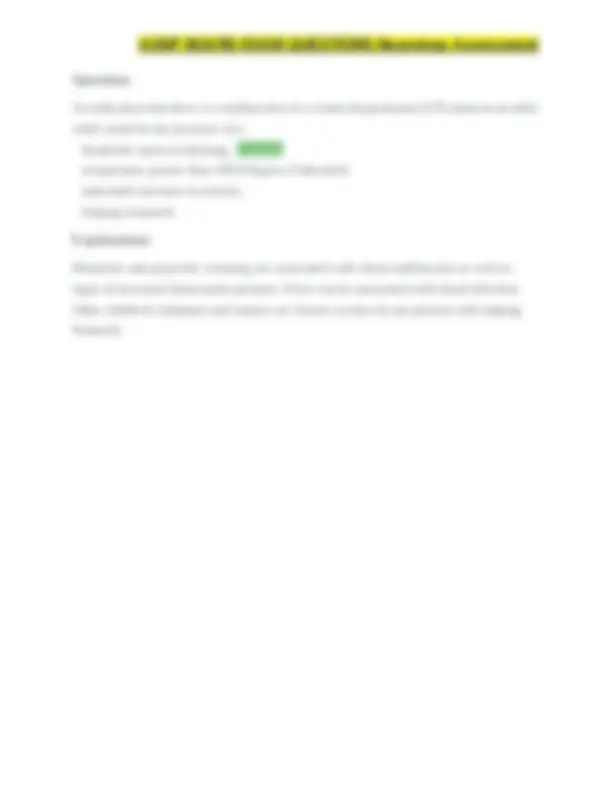
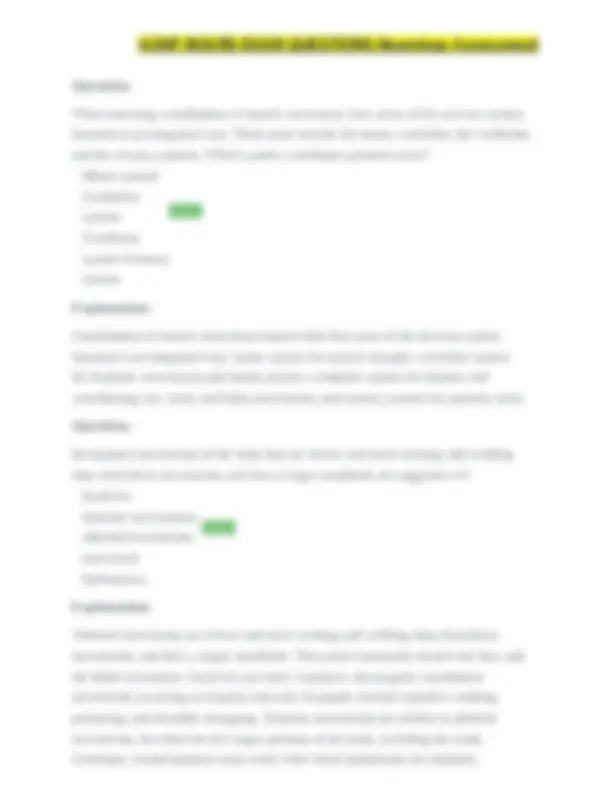
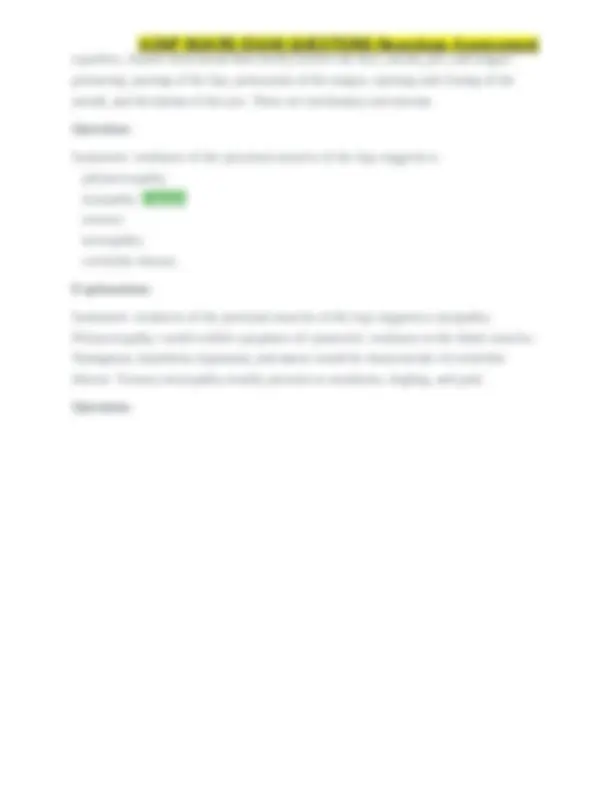
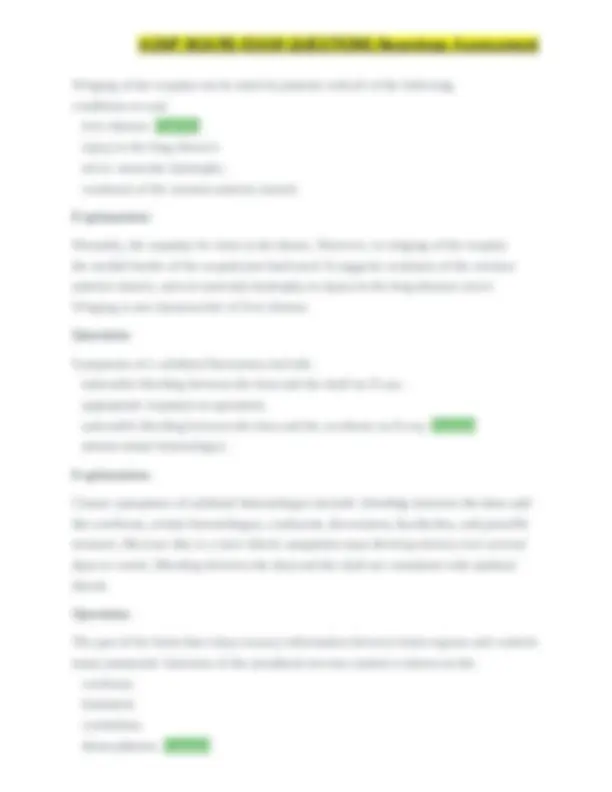

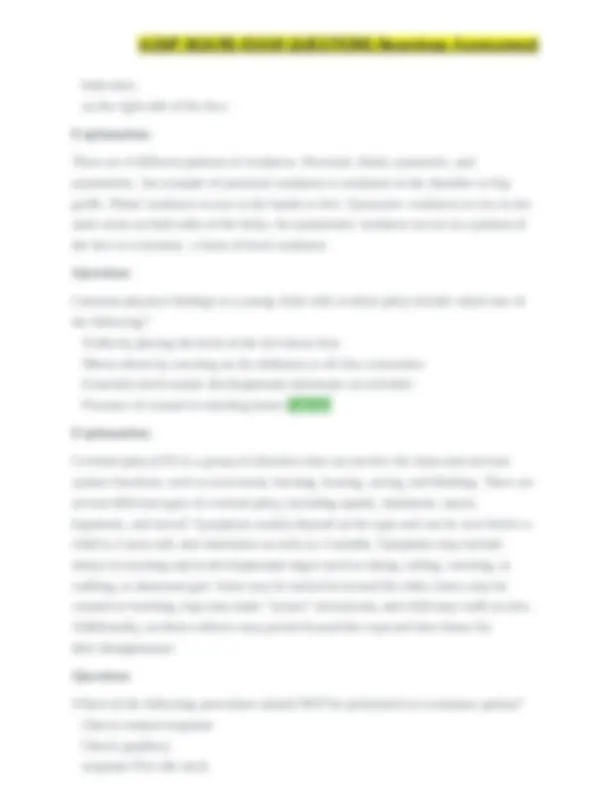
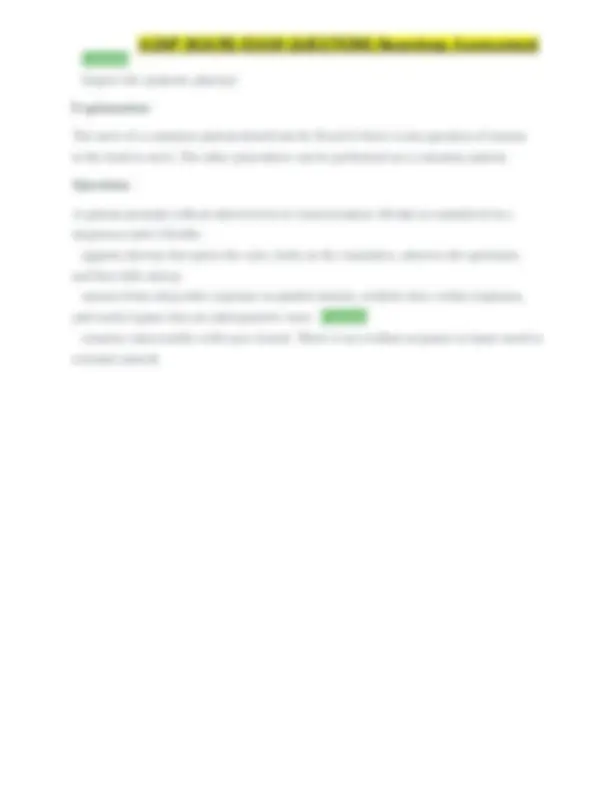
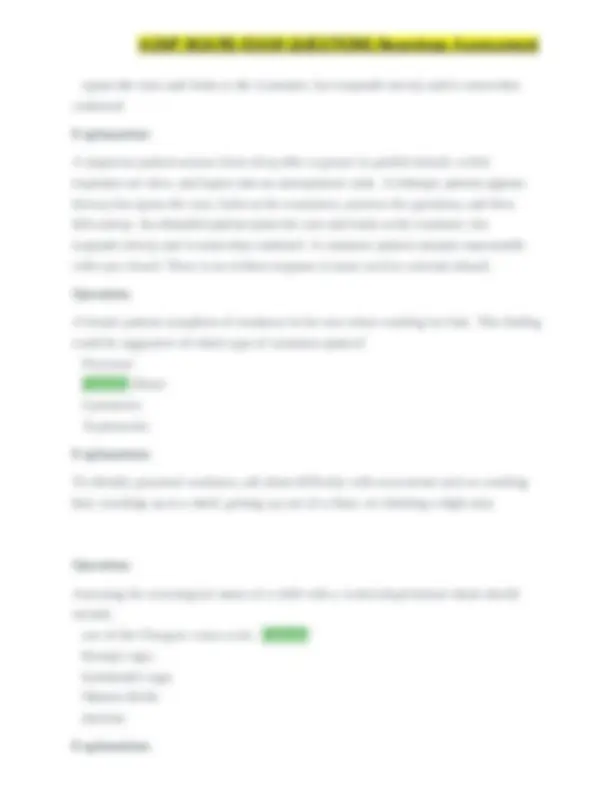
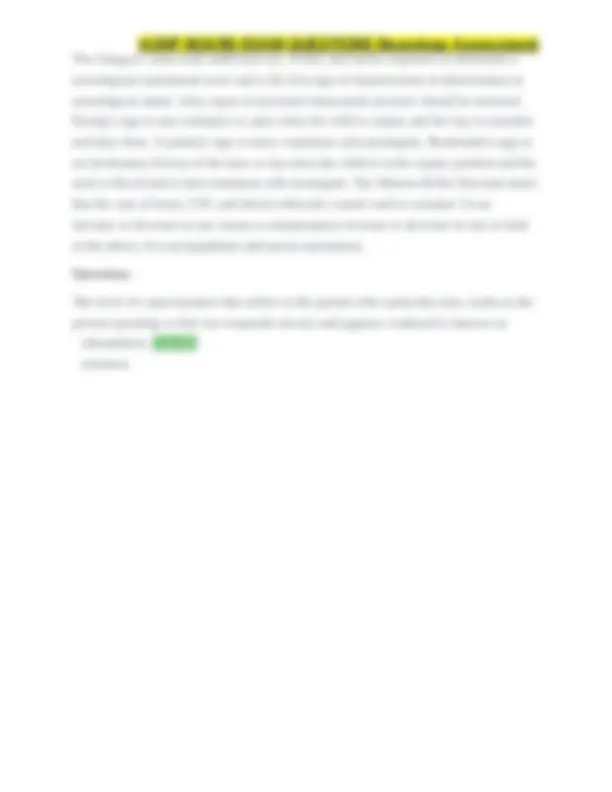


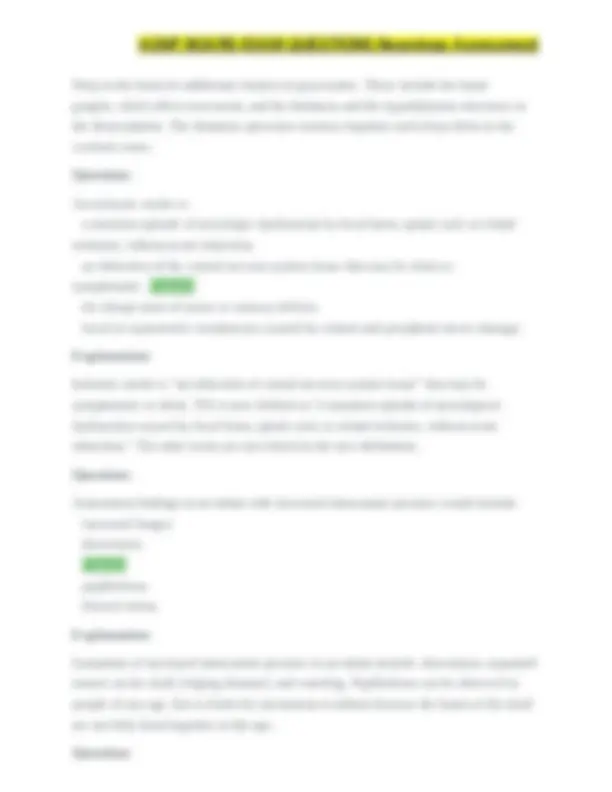
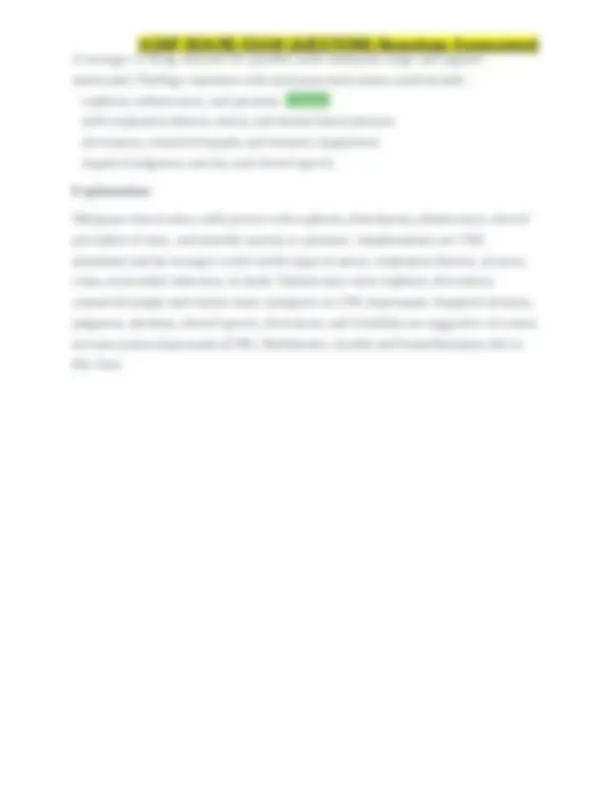

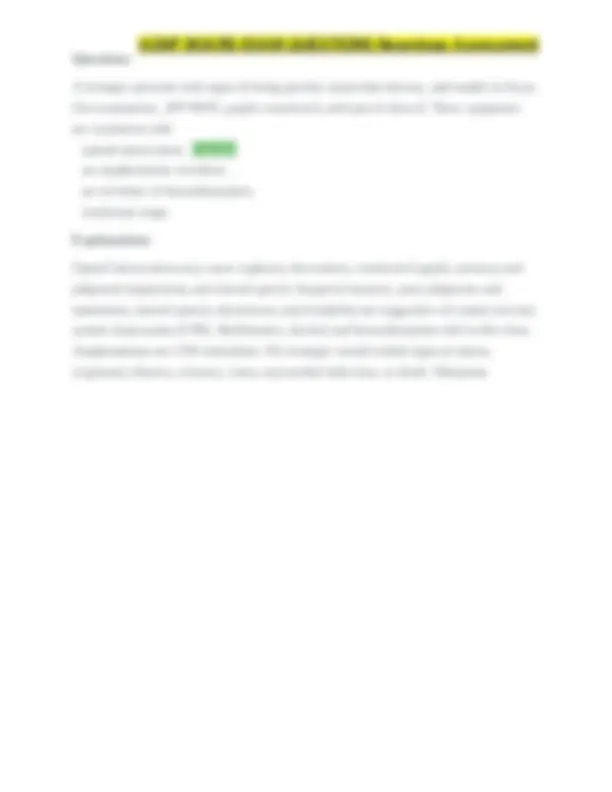


Study with the several resources on Docsity

Earn points by helping other students or get them with a premium plan


Prepare for your exams
Study with the several resources on Docsity

Earn points to download
Earn points by helping other students or get them with a premium plan
Community
Ask the community for help and clear up your study doubts
Discover the best universities in your country according to Docsity users
Free resources
Download our free guides on studying techniques, anxiety management strategies, and thesis advice from Docsity tutors
Information on assessing coordination and muscle weakness during a neurological examination. It covers various signs and symptoms, such as rapid alternating movements, point-to-point movements, gait, and dystonic movements. The document also discusses the importance of mental status assessment and the role of specific screening tools like the confusion assessment method (cam).
Typology: Exams
1 / 125

This page cannot be seen from the preview
Don't miss anything!





























































































AGNP BOARD EXAM QUESTIONS Neurology Assessment Question 1: When eliciting deep tendon reflexes in the knee, the nurse practitioner notes an abnormal reflex in the right knee. This abnormality is probably consistent with a pathological lesion in which segmented level of the spine? Cervical 5 and 6 Cervical 6 and 7 Lumbar 2, 3, and 4 Correct Sacral 1 Explanation: The segmented levels of the deep tendon reflexes are: Ankle: sacral 1; knee: lumbar 2,3, & 4; Supinator and biceps: cervical 5 & 6; and triceps: cervical 6 & 7. Question: A 80 year old male visits the nurse practitioner for an annual well exam. History reveals two falls in the prior 12 months and difficulty with balance. The next step the nurse practitioner should take is: reassess the patient in 6 months. obtain cognitive and functional assessment. Correct assess respiratory assessment. assess cardiac function.
Explanation: High-risk older adults, namely those with a single fall in the past 12 months with abnormal gait and balance and those with two or more falls in the prior 12 months, an acute fall, and/or difficulties with gait and balance, require further assessment to determine the reasons for the falls. Obtaining relevant medical history, physical exam, cognitive and functional assessment and determining multifactorial fall risks are essential to the preventing future falls. Question: When evaluating the sensory system, testing the spinothalamic tracts would include assessing sensations of: position and vibration. pain and temperature. Correct deep touch. discriminative sensations.
one the right side of the face. Explanation: There are 4 different patterns of weakness: Proximal, distal, symmetric, and asymmetric. An example of proximal weakness is weakness in the shoulder or hip girdle. Distal weakness occurs in the hands or feet. Symmetric weakness occurs in the same areas on both sides of the body. An asymmetric weakness occurs in a portion of the face or extremity - a form of focal weakness. Question: One maneuver used to assess coordination is to observe the patient: dorsiflexing the ankle. walking heel-to-toe in a straight line. Correct squeezing the examiner's fingers. counting to 10 backwards. Explanation: To assess coordination, observe the patient’s performance in rapid alternating movements, point-to-point movements, gait and other related body movements, standing in specified ways. Walking heel-to-toe would be an example of observing the patient's gait. Dorsiflexion would be assessing the patient's joint function. Squeezing the examiner's fingers would be one way to assess hand grasp. Counting has nothing to do with coordination.
Assessment of a 70-year-old's ability to maintain personal safety would be most adversely affected by declining function in the: cardiovascular system. respiratory system. sensory perception system. Correct gastrointestinal system. Explanation: The sensory system or sensory perception involves vision, touch, taste, smell, and hearing. With the aging process these perceptions are altered and these alterations put the elderly at risk for falls, burns, inability to smell smoke, and the inability to move fast enough to get out of harm's way. These impact personal safety. Changes in the cardiovascular, gastrointestinal, and respiratory systems do not usually lead to safety issues. Question: A patient complains of experiencing symptoms of nausea, diaphoresis, and pallor triggered by a fearful or unpleasant event. These symptoms are most likely associated with: subarachnoid hemorrhage. stroke. neurocardiogenic syncope. vasovagal syncope. Correct Explanation: In vasovagal syncope, a common cause of syncope, a prodrome of nausea, diaphoresis, and pallor are triggered by a fearful or unpleasant event, then vagally mediated hypotension, often with slow onset and offset. In syncope from arrhythmias, onset and offset are often sudden, reflecting loss and recovery of cerebral perfusion. Stroke or subarachnoid hemorrhage are unlikely to cause syncope unless there are focal findings
Question: Postural tremors appear when the affected part is: at rest. moving voluntarily. is actively maintaining a posture. Correct getting closer to its target. Explanation: Tremors are rhythmic oscillatory movements. Postural tremors appear when the affected part is actively maintaining a posture. Examples include the fine rapid tremor of hyperthyroidism, the tremors of anxiety and fatigue, and benign essential tremor. The other choices are not consistent with postural tremors. Question: Dysphonia refers to: the inability to produce or understand language. the loss of voice. an impairment in volume of the voice. Correct a defect in the muscular control of the speech apparatus. Explanation: Dysphonia refers to less severe impairment in the volume, quality, or pitch of the voice. Aphonia refers to a loss of voice that accompanies disease affecting the larynx or its nerve supply. Dysarthria refers to a defect in the muscular control of the speech apparatus (lips, tongue, palate, or pharynx). Aphasia refers to a disorder in producing or understanding language. Question: Symptoms of a migraine headache can include throbbing, nausea or vomiting, duration of one day, and be unilateral and/or disabling. How many of these symptoms should be present to classify the headache as a migraine? One of the five Two of the five
Three of the five Correct Four of the five Explanation: A migraine headache is highly likely if three of the five “POUND” features are present: Pulsatile or throbbing; One-day duration, or lasts 4 to 72 hours if untreated; Unilateral; Nausea or vomiting; Disabling or intensity causing interruption of daily activity. Question: The cranial sutures are closed on the head of a 9 month old infant. This indicates: hydrocephalus. craniosynostosis. Correct a normal finding. opisthotonos. Explanation:
The least invasive, least expensive, most efficient strategy used to detect cognitive and developmental deficits in infants and children is assessing for achievement of developmental milestones. Delay in achievement of developmental milestones is a cardinal sign of deficits/disabilities. The other three choices may be done at a later date as the child gets older and after the child is identified as having delayed or failure to achieve milestones. Question: A term used to describe an increase in muscular bulk with diminished strength is: hypertrophy. muscular atrophy. pseudohypertrophy. Correct muscle weakness. Explanation: An increase in muscular bulk with diminished strength is known as pseudohypertrophy. Hypertrophy refers to an increase in bulk of the muscle with a proportionate increase in
strength. A term used to describe muscle wasting or loss of muscle bulk is muscular atrophy. Muscular weakness is a term used to describe a lack of strength or firmness in a muscle. Question: A 40-year-old male presents with complaints of headaches. History reveals headaches that occurred daily for about 4-6 weeks. He had relief for 6 months but now they are recurring. These are most likely: tension headaches. cluster headaches. Correct migraine headaches. sinus headaches. Explanation: Headaches that are episodic with several each day for 4-6 weeks with an extended period of relief for 6-12 months are most likely cluster headaches. Cluster headaches are more common in men than women. Question: It is imperative to assess for suicidality and bipolar disorder in patients suspected of experiencing: delirium. autism spectrum disorder. depression. Correct attention deficit disorder. Explanation: Depression is more common in individuals with significant medical conditions, including several neurologic disorders—dementia, epilepsy, multiple sclerosis, and Parkinson disease. Patients who present with depression may actually have bipolar disorder and so screening should always take place. Patients who are depressed may be suicidal. Consequently, in order for appropriate treatment to occur, appropriate diagnosis must occur.
Question: Brief, repetitive, stereotyped, coordinated movements occurring at irregular intervals are consistent with: facial tics. Correct dystonic movements. athetoid movements. oral-facial dyskinesias. Explanation: Facial tics are brief, repetitive, stereotyped, coordinated movements occurring at irregular intervals. Examples include repetitive winking, grimacing, and shoulder shrugging. Dystonic movements are similar to athetoid movements, but often involve larger portions of the body, including the trunk. Grotesque, twisted postures may result. Athetoid movements are slower and more twisting and writhing than choreiform movements, and have a larger amplitude. They most commonly involve the face and the distal extremities. Oral–facial dyskinesias are rhythmic, repetitive, bizarre movements that chiefly involve the face, mouth, jaw, and tongue: grimacing, pursing of the lips, protrusions of the tongue, opening and closing of the mouth, and deviations of the jaw. These are involuntary movements. Question: On examination of the adult patient, symptoms of flexed posture, tremor, rigidity, and shuffling gait are observed. These findings are consistent with: drug induced reaction. functional impairment. Parkinson's disease. Correct depression. Explanation: Evidence of flexed posture, tremor, rigidity, bradykinesia, micrographia, shuffling gait, and difficulty rising from a chair are symptoms consistent with Parkinson's disease. Question:
When a patient complains of severe headaches that have worsened over the last few weeks but she has no other symptoms, a most likely diagnosis would be: sinusitis. a tumor. Correct subarachnoid hemorrhage. an abscess. Explanation: The most important attributes of headaches are chronologic pattern and severity. Changing or progressively severe headaches increase the likelihood of tumor, abscess, or other masses. Extremely severe headaches suggest subarachnoid hemorrhage or meningitis and these headaches require immediate intervention because they worsen rapidly, not over a "few weeks". Sinusitis does cause headache but these headaches are not usually severe. Question:
Explanation: Parkinson's disease is a progressive disorder of the nervous system that affects movement. Delirium is a serious disturbance in a person's mental abilities that results in a decreased awareness of one's environment and confused thinking. Cognitive impairment is an intermediate stage between the expected cognitive decline of normal aging and the more serious decline of dementia. Alzheimer's disease is a geriatric condition in which normal alertness is present but progressive global deterioration of cognition occurs in multiple domains, including short-term memory, but with sparing of memory for remote events, subtle language errors, visuospatial perceptual difficulties, and changes in executive function, or the ability to perform sequential tasks such as instrumental activities of daily living (IADLs). Question: Physical exam of a well two-week-old infant reveals a little dimple with a small amount of hair just above the sacral area. This could be: an unusual finding but within normal limits.
hirsutism. Arnold -Chiari malformation. spina bifida occulta. Correct Explanation: There are four types of spina bifida: occulta, closed neural tube defects, meningocele, and myelomeningocele. Occulta is the mildest and most common form in which one or more vertebrae are malformed. The name “occulta,” which means “hidden,” indicates that a layer of skin covers the malformation, or opening in the vertebrae. This form of spina bifida, present in 10-20 percent of the general population, rarely causes disability or symptoms. Closed neural tube defects are often recognized early in life due to an abnormal tuft or clump of hair or a small dimple or birthmark on the skin at the site of the spinal malformation. Meningocele and myelomeningocele generally involve a fluid- filled sac—visible on the back—protruding from the spinal canal. In meningocele, the sac may be covered by a thin layer of skin. In most cases of myelomeningocele, there is no layer of skin covering the sac and an area of abnormally developed spinal cord tissue is usually exposed. Hirsutism is an excessive amount of hair on the body usually caused by a hormonal imbalance. An Arnold- Chiari malformation is a cyst-like formation in the fourth ventricle, cerebellum or brainstem. Question: The patient experiences a sudden loss of consciousness with falling without movements and injury may occur. This type of a seizure is consistent with: a myoclonic seizure. an absent seizure. a myoclonic atonic seizure. Correct a focal seizure with impairment of consciousness. Explanation: During a myoclonic atonic seizure, the patient experiences a sudden loss of consciousness with falling but no movements. Injury may occur. A patient
indicate a corticospinal lesion originating in the contralateral hemisphere. An upward drift would be indicative of a lesion in the cerebellum. This test is called the Test for Pronator Drift and is used to test for upper motor neuron disease. Question: To identify sensory deficits comparing symmetric areas, the nurse practitioner would compare the sensation: in the thumb to that in the little finger. in both arms. Correct by mapping out the area of sensory loss. and vibration in the fingers or toes. Explanation: To identify sensory deficits by comparing symmetric areas, the nurse practitioner would compare the sensation on both sides of the body. For example, the right arm should have the same perception of sensation as the left arm. An example of a comparison of the distal with proximal areas, the sensation in the thumb would be compared to that in the little finger. Mapping an area of sensory loss or hypersensitivity would be assessed by stimulating first the point of reduced sensation and moving by progressive steps until the patient detects the change. When testing vibration and position, first test the fingers and toes. Question: The three important questions that govern the neurological examination include: Is the mental status intact?, Are right-sided and left-sided findings symmetric?, and: Are deep tendon reflexes intact?. Are vital signs stable? If findings are abnormal, is the cause in the central or peripheral nervous system?. Correct Are the cranial nerves intact?. Explanation: The three important questions that govern the neurological examination include: Is the mental status intact?, Are right-sided and left-sided findings symmetric?, and If
findings are abnormal, is the cause in the central or peripheral nervous system?. The other questions are also important to ask but are not included in the 3 most important ones for the neurological exam. Question: The level of consciousness that refers to the ability of the patient to respond fully and appropriately to stimuli is known as: obtundation. alertness. Correct lethargy. stupor. Explanation: The level of consciousness that refers to the ability of the patient to respond fully and appropriately to stimuli is known as alertness. An obtunded patient opens his eyes,